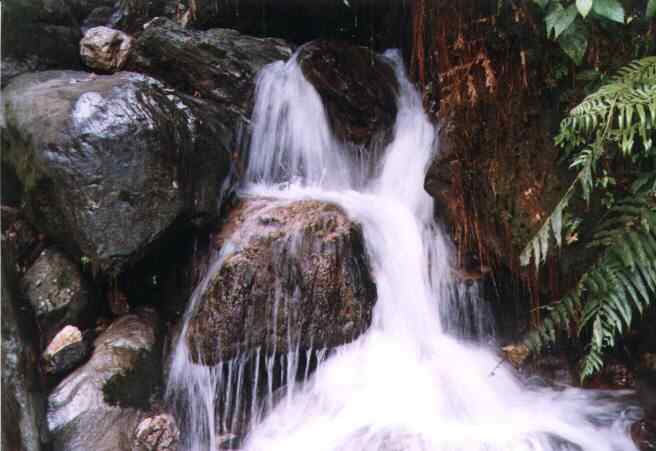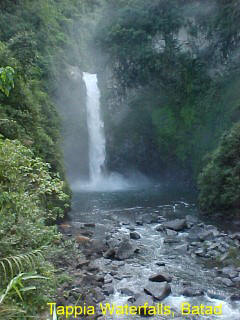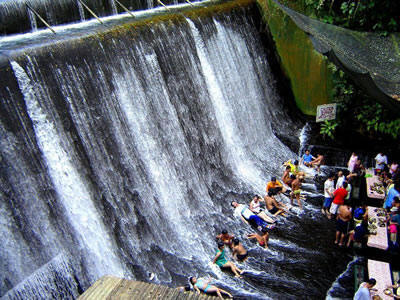|
Waterfalls in the Philippines Our waterfall still hides behind the winding and steeply rising walls of the jungle ravine with its opulent rain forest vegetation. But a roaring in the distance has already announced it and it is mobilizing our last ounce of strength. We slog along forward in the heat passing the slippery stones of the creek. The roaring increases, becomes more and more thundering. Finally the waterfall appears and we see how the water masses are tossing over an overhanging rock partly getting sprayed to fine whitish spindrifts and fogs. It seems we are hypnotized by the close encounter with the natural spectacle. Splashing water and sprays forming gloriously colourful rainbows under the sun - start to capture us. In the impact zone of cascading water we find very often a basin or pool inviting swimmers with its cool water. Calls like "Majestic!" "Wonderful!" can be heard. Behind the drumming thick curtain of the water courageous visitors and swimmers disappear in a dark cave populated with bats.
Visitors of one of the many waterfalls in the
Philippines can experience such or rather similar encounters. And
there are a lo There are different ranking lists of worldwide waterfalls (Height, discharge of water, scenery, grandeur etc.) With regard to the criterion height none of the Philippine waterfalls belongs to the top ten. The highest waterfall in the world is the Angel Fall in Venezuela with 979 metres. And no Philippine waterfall can approach the Khone Falls in Laos, which is only 22 metres high but discharges round about 11,600 cubic metres of water in the second. Top leader with regard to height in the Philippines are the Aliwagwag Falls (Davao Oriental) with 338 metres, followed by the Limunsudan Falls (Lanaos del Norde) with 265 metres and the Busay Falls (Albay) with 243 metres. Another grouping criterion could be the beauty or grandeur of a waterfall. This criterion is, however, very subjective. In our introduction of prominent Philippine waterfalls we have therefore decided to follow geographical location. We will start in the north of Luzon. Our short list is surely incomplete. We know that each waterfall is worth of a more detailed description. However, this would lead to many text repetitions, because most of them have charming rain forest vegetation (with tropical trees, tall bamboo and giant ferns) and a pool for swimming. Northern Luzon Pinsal Falls: The tallest terraced waterfall in the province Ilocos near the town of Santa Maria - height of fall 25 metres a hidden cave behind the main waterfall Stimson Falls: Lees known terraced waterfall with a height of 152 metres named after an American Governor General Tappia Waterfalls: In the neighbourhood of the rice terraces of Batad 20 metres high Big Falls (also Bomol-ok Falls): 40 metres high, forked waterfall near Sagada a trekking tour which includes also the rice terraces and the Big Cave there is recommended Pagsanjan Falls: Best known waterfall near Manila (town of Pagsanjan) and an overrun tourist destination The last passage only accessible by narrow bancas in an approximately one-hour boat trip - forked waterfall with a height of 30 metres in midst rain forests with a pool and a cave, which can be visited. It is sometimes told that the boat trip is offering more thrills (torrential mountain river; spray water because of eleven rapids; 100 metres high rock faces covered by rain forest plants) than the waterfall itself. Southern Luzon Bicol: Busay Falls: 20 km away from Legaspi last stretch only able to be reached on foot - seven-stage waterfall with a total height of 243 and an average width of six metres - the first drop is 91 metres and the second 40 metres high Swimming in the impact zone not altogether harmless. Itbog case: Twin waterfall in the neighbourhood of Mount Isarog nearby the town of Iriga - height 12 metres - rain forest scenery Botong case: About 30 metres high "twin" waterfall nearby the town of Sorsogon - new tourist attraction with an artificial pool. Visayas Negros: Negros is the native country of many waterfalls Casaroro Falls: 9 kilometres away from Dumaguete nearby the town of Valencia - drop round about 40 metres- swimming in the pool in the rainy season risky - forest vegetation Quipot case: near the town of Kanlaon and the still active volcano Mount Kanlaon - Quipot Falls takes the shape of a bottle - height of fall about 100 metre - rain forest surroundings Waterfalls of Sudlon: likewise nearby the town of Kanlaon; two waterfalls in a distance of 120 metres with a high of 25 metres Bohol: The waterfalls are primarily concentrated in the southwest of the island. Mag-Aso Falls: about 20 km north-western of Tagbiliran nearby the town of Antiquera; terraced waterfall with a height of eight metres In the neighbourhood also Inambacan Falls, Kawasan Falls, Dimia Twin Falls, Busay Falls (12 metres wide and 4 metres high) Samar Amandaraga Falls: In the eastern part of the island near the place Lawaan a waterfall curly like a maiden hair with a 120 metres height - jungle trip Cebu: Kawasan Falls: Cascading waterfall in the south near the village Badian last step 20 metres high - touristical development of scenery Mindoro: Tamaraw Falls: about 15 kilometres away from Puerto Galera with easy access tiered, asymmetric waterfall - last step 132 metres drop Mindanao Mindanao shows a lot of waterfalls. The city of Iligan with its more than 20 waterfalls is also known as the City of Majestic waterfalls. Tinago Falls: A 73 metres high beautiful waterfall in the north Mindanaos near the City of Iligan hidden in a ravine - tourist attraction Maria Cristina Falls: likewise nearby the city of Iligan; channelled "twin" waterfall - height of fall of 80 metres - tourist attraction - partly used commercially (hydroelectric plant) Alalum Fall: near the village Sumilao- height of fall of 45 metres Dodiongan Falls: 15 km remote from Iligan drop 20 metres - tourist destination Limunsudan Falls: second highest waterfall in the Philippines 55 kilometres away from Iligan with two steps - total drop 265 metres - highest step measures 122 metres - average breadth 23 metres - about 3 cubic metres of water are flowing down per second Aliwagwag Falls: situated in the southeast Mindanaos near the village Cateel one of the most beautiful waterfalls in the Philippines with a total height of 3348 metres it shows 84 steps with heights between 2 and 30 metres and an average breadth of about 20 metres in the meantime all cascades can be visited
Todaya Falls: spectacular 91 metres high waterfall at the foot of Mount Apo (Davao) with an average breadth of 13 metres Seven Waterfalls: As the name suggests it is a 7-step waterfall in the neighbourhood of Lake Sebu - total length about three kilometres - only the first (12 metres) and the second step (Dongon Waterfall with 24 metres of height) is accessible - further touristy developments are now planned. Legends Waterfalls have captivated from time immemorial. No wonder that they appear also in Philippine legends. After legend the Pagsanjan Falls came into being when the pre-forefather Magdapio after a long time of terrible drought and unanswered flung his big stick in a rage in rage against the rocks. From the Pinsay Falls in Ilicos is told that it represents the big footprint of the giant Angalo, when he chased his loved giantess Aran. Maria Cristina Falls owe it name two sisters who lived nearby the waterfalls. Both loved themselves very much. For a long time the two sisters Maria and Cristina refused the marriage offers of datus and sultans. One day, however, a young man comes who opens the hearts of the two. But oh my goodness - the two sisters do not know whom of both the young man really loves. The tragedy takes its run now. The two sisters jump from the waterfall to their death one after the other. Now the young man is very sad. He buries their bodies under the waterfall and he is the one who gives the waterfall its name after the names of the two sisters. For inactive connoisseurs Waterfalls are fascinating this fact did not remain unconcealed by resourceful business men. Now they are offering man-made light waterfalls with a corresponding ambiance for a wealthy clientele. The Labasin Waterfalls in San Pablo (Laguna Province) is an example of such a relaxing waterfall pleasure without physical effort.
© W. Bethge, 2008 |



